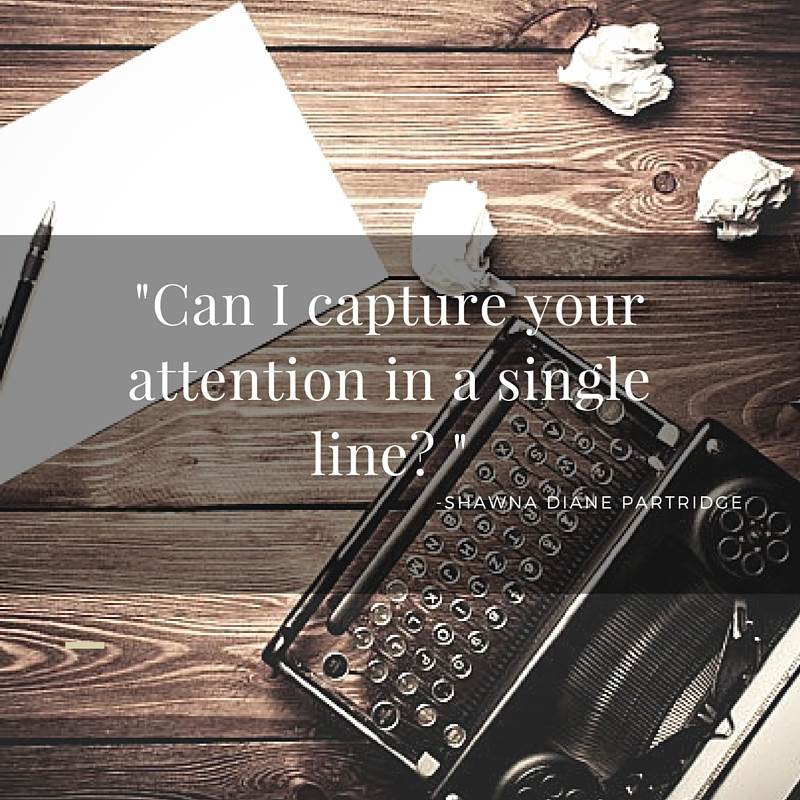Atwood’s Challenge

Can I capture your attention in a single line?
A poor graduate student as I was in 2014, I had the good fortune to be given tickets to a fundraiser in the city where I was studying, Windsor, Ontario. This was no mere fundraiser; it featured Windsor-born author Wayne Grady and hosted by Margaret Atwood (name drop). In my foam green dress and concealing a pen and copy of Cat’s Eye in my purse, I waited at the student’s table for Atwood. She circled around the room, exchanging greetings. I sat glued to my chair for the chance to speak with her and have her autograph the book. Margaret was magnificent with her white dusted, wild and curly hair. When she arrived at my table, she offered few but precise words of advice to me and the other aspiring writers. While I stared at her so-Atwood hair, she stated, “Make the first line good”.
At that time, I was completing the first year of my Master’s degree in Creative Writing at the University of Windsor. I was researching and outlining my thesis which was to be a fiction novella set in my hometown of Sault Ste. Marie, Ontario. After graduate school in 2015, I took that summer to revise my thesis manuscript and later submit it to Latitude 46 Publishing (but I’m getting ahead of the story).
I took Atwood’s advice as a challenge. When writing my thesis, I had to make the opening line of my novella, good. I couldn’t disappoint Atwood, could I? So I wrote and in the spring of 2015, I defended my thesis. Afterwards in refining the manuscript for submission to Latitude 46, I knew I didn’t meet Atwood’s challenge. My thesis’ opening line went like so: “The day began with thunder, then, heavy rain punctuated by lightning strikes so near the house, they rattled the windows”. The line had strong images, of rain and thunder. For that reason, I didn’t omit the line but it wasn’t opening-line quality (the line does appear in Rule of Seconds, published by Latitude 46, but as the book’s second line). It was powerful, but lacking. What though? I couldn’t explain it better than the line lacked something, a “punch”.
What was a writer to do for guidance and inspiration? I looked to some Canadian heavyweights:
My father came across the field carrying the body of the boy who had been drowned.
(p. 121, Alice Munro, “Miles City, Montana”, Alice Munro’s Best: Selected Stories,
McClelland & Stewart, Toronto, 2006)
They’re all dead now.
(p. 1, Ann-Marie MacDonald, Fall on Your Knees, Vintage Canada, Toronto, 1997)
The river flowed both ways.
(p. 3, Margaret Laurence, The Diviners, McClelland & Stewart, Toronto, 2007)
People, years later, blamed everything on the bees;
(p. 1, Robert Kroetsch, What the Crow Said, The University of Alberta Press, Edmonton, 1998)
And of course,
Time is not a line but a dimension, like the dimensions of space.
(p. 1, Margaret Atwood, Cat’s Eye, McClelland & Stewart, Toronto, 1988)
I asked myself, “What can I learn from these lines? What do they have in common? As a reader, why did they draw me in, make me proceed to the next line and onwards?” I examined each line from the perspective of a writer and reader. A writer is always writing for someone, some reader, even if it’s only for him or herself. I determined that those first lines were all to the point, shaved down, any fluff removed. Each created a single image or idea: a man carrying a limp body across a flat grassy field; of death, black-and-white photographs coming to mind; water flowing up and down stream; buzzing of thousands of bees; of time, endless black space.
Reaching some answers, I then asked another question, “What image or idea did I want my reader to imagine from the book’s first line?” I didn’t know what the line would say, but I knew how I wanted it to be: sharp, concise, no fluff. One clear image.
In the last round of edits before publication, I finally decided on the book’s opening line.
When a reader first opens the book to read it or decide whether to buy it, they see this line: “It begins, always, with the eyes”. The eyes, defined image, recognizable, easily imagined. Those opening words, reflecting the reader’s own eyes on the inked page.
As writers, do we accept Atwood’s challenge, to “Make the first line good”?
By the way, later that night at the fundraiser, Atwood did autograph my copy of Cat’s Eye. Ever since, it has been proudly displayed on my bookcase, top shelf, with the spine uncracked.
– Shawna Diane Partridge




